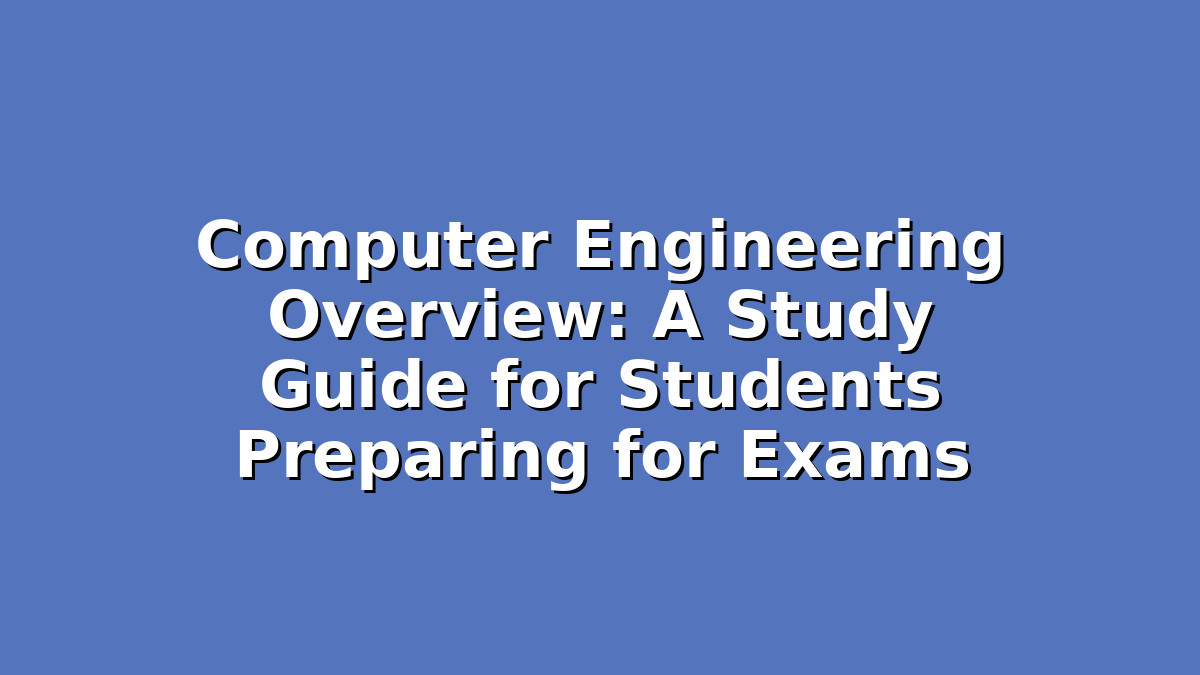Introduction
Computer engineering is an exciting and rapidly evolving field that combines elements of electrical engineering and computer science to design, develop, and optimize computer systems and hardware. For students preparing for exams or looking to strengthen their understanding, gaining a clear overview of computer engineering is crucial. This article aims to offer a comprehensive introduction to computer engineering with useful study tips that will help you excel in your courses and perform confidently in exams.
Whether you are tackling subjects like digital logic design, microprocessors, programming, or embedded systems, having a well-rounded knowledge base and effective study techniques will make your learning journey smoother and more rewarding. Let’s dive into the core areas of computer engineering and explore strategies tailored to help you master each topic.
Section 1: Understanding the Fundamentals of Computer Engineering
At its core, computer engineering involves the design and development of both hardware and software components of computer systems. The fundamentals usually cover topics such as digital logic design, computer architecture, microprocessors, circuits, and programming languages.
Key Topics to Focus On:
– Digital Logic and Boolean Algebra: This is the foundation of how computers process information using binary numbers, logic gates, and circuits.
– Computer Architecture: Understanding how the CPU, memory, buses, and input/output devices work together.
– Microprocessors and Microcontrollers: Learning how these small but powerful chips function and control systems.
– Programming: Typically in languages like C, C++, or assembly, which is essential for creating software to run on hardware.
Study Tips for Fundamentals:
1. Concept Mapping: Create visual maps linking topics like logic gates, truth tables, and flip-flops to form a clear picture of digital circuits.
2. Practice Problems: Work on textbook exercises and past exam questions regularly. Digital logic and circuit design concepts become much easier with practice.
3. Use Simulators: Tools like Logisim or digital circuit simulators help you visualize and test logic circuits without physical hardware.
4. Group Study: Discussing complex topics like CPU architecture with peers can deepen your understanding.
Section 2: Developing Strong Programming and Software Skills
Programming is an indispensable part of computer engineering. Being comfortable with coding not only helps in software development but also in understanding hardware behavior, because many hardware components are programmed via embedded systems.
Key Programming Areas to Master:
– Low-Level Programming: Understanding assembly language and how it interacts with hardware.
– High-Level Programming: Languages such as C and C++ are widely used in system programming.
– Embedded Systems Programming: Writing software that runs on microcontrollers and embedded devices.
– Algorithm Design and Data Structures: Essential for efficient problem-solving and software development.
Study Tips for Programming:
1. Code Regularly: Practice coding daily or as often as possible to build fluency.
2. Work on Projects: Apply concepts by building small projects like calculators, traffic light controllers, or simple games.
3. Debug Systematically: Learn debugging skills to identify and fix errors efficiently.
4. Use Online Platforms: Websites like LeetCode, HackerRank, or CodeSignal offer problem sets that improve coding and algorithm skills.
5. Understand the ‘Why’: Don’t just memorize syntax—strive to understand how and why code works to deepen your programming knowledge.
Section 3: Mastering Hardware and Systems Integration
Computer engineers often bridge the gap between software and hardware. Understanding how to integrate these elements is essential, especially when working on embedded systems, robotics, or IoT devices.
Important Hardware and Systems Topics:
– Microcontroller Architecture and Programming: The heart of many embedded systems.
– Signal Processing and Circuit Analysis: For designing and testing electrical components.
– Operating Systems Fundamentals: Concepts like memory management, processes, and hardware-software interaction.
– System Design and Integration: Combining multiple components to build a functional system.
Study Tips for Hardware and Systems:
1. Hands-On Practice: If possible, get access to development boards like Arduino or Raspberry Pi to experiment with real hardware.
2. Lab Sessions: Take full advantage of lab classes to gain practical experience with circuit design and testing.
3. Break Down Complex Systems: When studying system integration, dissect systems into smaller parts to understand how each component works.
4. Relate Theory to Practice: Connect theoretical concepts like interrupt handling or bus communication to real-world examples.
5. Use Visual Aids: Diagrams, flowcharts, and schematics can help you visualize hardware connections and data flow.
Conclusion
Computer engineering is a dynamic and multifaceted discipline that requires a solid grasp of both hardware and software principles. As a student preparing for exams, focusing on fundamental concepts, honing your programming skills, and gaining hands-on experience with hardware will create a strong foundation for success. Remember, steady practice, active learning, and using the right study tools will boost your confidence and improve retention.
Approach your studies with curiosity and patience. Don’t hesitate to seek help from professors, join study groups, or use online resources to clarify doubts. With dedication and the right strategies, you’ll be well on your way to mastering computer engineering concepts and excelling in your exams.

Responses